Assessment |
Biopsychology |
Comparative |
Cognitive |
Developmental |
Language |
Individual differences |
Personality |
Philosophy |
Social |
Methods |
Statistics |
Clinical |
Educational |
Industrial |
Professional items |
World psychology |
Animals · Animal ethology · Comparative psychology · Animal models · Outline · Index
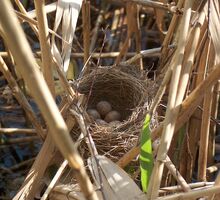
Deep cup nest of the Great Reed-warbler (Acrocephalus arundinaceus)
A bird nest is the spot in which a bird lays and incubates its eggs and raises its young. While the term popularly refers to a specific structure made by the bird itself—such as the grassy cup nest of the American Robin or Eurasian Blackbird, or the elaborately woven hanging nest of the Montezuma Oropendola, the Village Weaver or the Red-browed Pardalote—that is too restrictive a definition. For some species, a nest is simply a shallow depression made in sand; for others, it is a burrow dug into the ground, a chamber drilled into a tree, an enormous rotting pile of vegetation and earth, or a mud dome with an entrance tunnel. Some species of cave swiftlets of the genus Collocalia make their nests entirely from their saliva which dries and hardens to form a bracket on the cave wall into which the birds lay their eggs.
The smallest bird nests are those of some hummingbirds, tiny cups which can be a mere 2 cm (less than one inch) across and 2–3 cm (about one inch) high.[1] At the other extreme, some nest mounds built by the Dusky Scrubfowl measure more than 11 m (34 ft) in diameter and stand nearly 5 m (15 ft) tall.[2]
In most species, the female does all or most of the nest construction, though the male often helps.[3] In some polygynous species, however, the male may do most or all of the nest building. The nest may also form a part of their courtship display such as in bowerbirds and weaver birds. The ability to choose and maintain good nest sites and build high quality nests may be selected for by females in these species. In some species the young from previous broods may also act as helpers for the adults.
Nest types[]
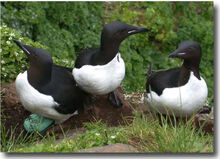
Thick-billed Murres (Uria lomvia) lay their single eggs directly onto rock ledges
Not every bird species builds or uses a nest. Some auks, for instance—including Common Murre, Thick-billed Murre and Razorbill—lay their eggs directly onto the narrow rocky ledges they use as breeding sites.[4] The eggs of these species are dramatically pointed at one end, so that they roll in a circle when disturbed. This is critical for the survival of the developing eggs, as there are no nests to keep them from rolling off the side of the cliff. Presumably because of the vulnerability of their unprotected eggs, parent birds of these auk species rarely leave them unattended.[5]
King and Emperor Penguins also do not build nests; instead, they tuck their eggs and chicks between their feet and folds of skin on their lower bellies. They are thus able to move about while incubating, though in practice only the Emperor Penguin regularly does so. Emperor Penguins breed during the harshest months of the Antarctic winter, and their mobility allows them to form huge huddled masses which help them to withstand the extremely high winds and low temperatures of the season. Without the ability to share body heat (temperatures in the center of tight groups can be as much as 10C above the ambient air temperature), the penguins would expend far more energy trying to stay warm, and breeding attempts would probably fail.[6]
A few species, such as the Eurasian Eagle-Owl[7] and Hume's Tawny Owl,[8] lay their eggs in the relative shelter of a crevice in the rocks or a gap between boulders, but provide no additional nest material.
Brood parasites, such as the New World cowbirds[9] and many of the Old World and Australasian cuckoos, lay their eggs in the active nests of other species.
Scrape[]
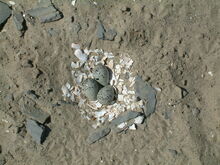
Shell-lined scrape nest of a Charadrius plover
The simplest nest construction is the scrape, which is merely a shallow depression in soil or vegetation.[10] This nest type, which typically has a rim deep enough to keep the eggs from rolling away, is sometimes lined with bits of vegetation, small stones, shell fragments or feathers.[11] These materials may help to camouflage the eggs or may provide some level of insulation; they may also help to keep the eggs in place, and prevent them from sinking into muddy or sandy soil if the nest is accidentally flooded.[12] Ostriches, most tinamous, many ducks, most shorebirds, most terns, some falcons, pheasants, quail, partridges, bustards and sandgrouse are among the species that build scrape nests.
Eggs and young in scrape nests—and the adults that brood them—are more exposed to predators and the elements than those in more sheltered nests; they are on the ground and typically in the open, with little to hide them. The eggs of most ground-nesting birds (including those that use scrape nests) are cryptically colored to help camouflage them when the adult is not covering them; the actual color generally corresponds to the substrate on which they are laid.[13] Brooding adults also tend to be well camouflaged, and may be difficult to flush from the nest. Most ground-nesting species have well-developed distraction displays, which are used to draw (or drive) potential predators from the area around the nest.[14] Most species with this type of nest have precocial young, which quickly leave the nest upon hatching.
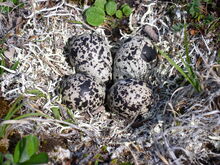
Lichen-lined scrape nest of the American Golden-Plover (Pluvialis dominica)
The technique used to construct a scrape nest varies slightly depending on the species. Beach-nesting terns, for instance, fashion their nests by rocking their bodies on the sand in the place they have chosen to site their nest,[15] while skimmers build their scrapes with their feet, kicking sand backwards while resting on their bellies and turning slowly in circles.[16] The Ostrich also scratches out its scrape with its feet, though it stands while doing so.[17] Many tinamous lay their eggs on a shallow mat of dead leaves they have collected and placed under bushes or between the root buttresses of trees,[18] and Kagus lay theirs on a pile of dead leaves against a log, tree trunk or vegetation.[19] Marbled Godwits stomp a grassy area flat with their feet, then lay their eggs, while other grass-nesting waders bend vegetation over their nests so as to avoid detection from above.[20] Many female ducks, particularly in the northern latitudes, line their shallow scrape nests with down feathers plucked from their own breasts, as well as with small amounts of vegetation.[21]
Among scrape-nesting birds, the Three-banded Courser and Egyptian Plover are unique in their habit of partially burying their eggs in the sand of their scrapes.[22]
Mound[]
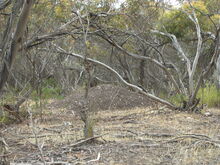
Mound nest of the Malleefowl (Leipoa ocellata)
Burying eggs as a form of incubation reaches its zenith with the Australiasian megapodes. Several megapode species construct enormous mound nests made of soil, branches, sticks, twigs and leaves, and lay their eggs within the rotting mass. The heat generated by these mounds, which are in effect giant compost heaps, warms and incubates the eggs.[1] Recent research has shown that much of the nest's heat results from the respiration of thermophilic fungi rather than fermentation, as had been previously believed.[23] The size of some of these mounds can be truly staggering; several of the largest—which contain more than 100 cubic meters of material, and probably weigh more than 50 tons[23]—were initially thought to be Aboriginal middens.[24]
In most mound-building species, males do most or all of the nest construction and maintenance.[25] Using his strong legs and feet, the male scrapes together material from the area around his chosen nest site, gradually building a conical or bell-shaped pile. This process can take five to seven hours a day for more than a month.[25] While mounds are typically reused for multiple breeding seasons, new material must be added each year in order to generate the appropriate amount of heat. A female will begin to lay eggs in the nest only when the mound's temperature has reached an optimal level.
Both the temperature and the moisture content of the mound are critical to the survival and development of the eggs, so both are carefully regulated for the entire length of the breeding season (which may last for as long as eight months), principally by the male.[23] Ornithologists believe that megapodes may use sensitive areas in their mouths to assess mound temperatures; each day during the breeding season, the male digs a pit into his mound and sticks his head in.[26]
One recent study showed that the sex ratio of hatchlings correlated strongly with mound temperatures; females hatched from eggs incubated at higher mean temperatures.[27]
Burrow[]
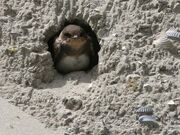
Sand Martin (Riparia riparia) at the entrance of its burrow nest
Soil plays a different role in the burrow nest; here, the eggs and young—and in most cases the incubating parent bird—are sheltered under the earth. Most burrow-nesting birds excavate their own burrows, but some use those excavated by other species; Burrowing Owls, for example, sometimes use the burrows of prairie dogs, ground squirrels and badgers, China's endemic White-browed Tits use the holes of ground-nesting rodents[28] and Common Kingfishers occasionally nest in rabbit burrows.[29] Puffins, shearwaters, some megapodes, motmots, todies, most kingfishers, the Crab Plover, miners and leaftossers are among the species which use burrow nests.
Most burrow nesting species dig a horizontal tunnel into a vertical (or nearly vertical) dirt cliff, with a chamber at the tunnel's end to house the eggs.[30] The length of the tunnel varies depending on the substrate and the species; Sand Martins make relatively short tunnels ranging from 50–90 cm,[31] for example, while those of the Burrowing Parakeet can extend for more than three metres.[32]
Not all burrow-nesting species incubate their young directly. Some megapode species bury their eggs in sandy pits dug where sunlight,[1] subterranean volcanic activity[1] or decaying tree roots[23] will warm the eggs.
Cavity[]
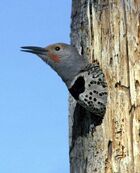
A Northern Flicker (Colaptes auratus) protruding from its cavity nest
The cavity nest is a chamber, typically in living or dead wood, but sometimes in the trunks of tree ferns[33] or large cacti, including saguaro.[33][34] In tropical areas, cavities are sometimes excavated in arboreal insect nests.[35][36] A relatively small number of species, including woodpeckers, trogons, some nuthatches and many barbets, can excavate their own cavities. Far more species—including parrots, tits, bluebirds, most hornbills, some kingfishers, some owls, some ducks and some flycatchers—use natural cavities, or those abandoned by species able to excavate them; they also sometimes usurp cavity nests from their excavating owners. Cavity-nesting species can be enticed to use bird houses (also known as nest boxes); these mimic natural cavities, and can be critical to the survival of species in areas where natural cavities are lacking. The term primary cavity-nester is used for species that excavate the nests while secondary cavity-nesters use existing cavities including those made by primary cavity-nesters.
Woodpeckers use their chisel-like bills to excavate their cavity nests, a process which takes, on average, about two weeks.[34] Cavities are normally excavated on the downward-facing side of a branch, presumably to make it more difficult for predators to access the nest, and to reduce the chance that rain floods the nest.[37] There is also some evidence that fungal rot may make the wood on the underside of leaning trunks and branches easier to excavate.[37] Most woodpeckers use a cavity for only a single year. The endangered Red-cockaded Woodpecker is an exception; it takes far longer—up to two years—to excavate its nest cavity, and may reuse it for more than two decades.[34] The typical woodpecker nest has a short horizontal tunnel which leads to a vertical chamber within the trunk. The size and shape of the chamber depends on species, and the entrance hole is typically only as large as is needed to allow access for the adult birds. While wood chips are removed during the excavation process, most species line the floor of the cavity with a fresh bed of them before laying their eggs.
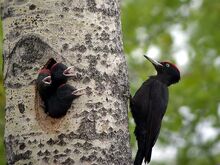
Black Woodpecker youngsters (Dryocopus martius) in their cavity nest
Trogons excavate their nests by chewing cavities into very soft dead wood; some species make completely enclosed chambers (accessed by upward-slanting entrance tunnels), while others—like the extravagantly-plumed Resplendent Quetzal—construct more open niches.[36] In most trogon species, both sexes help with nest construction. The process may take several months, and a single pair may start several excavations before finding a tree or stump with wood of the right consistency.
Species which use natural cavities—or old woodpecker nests—sometimes line the cavity with soft material such as grass, moss, lichen, feathers or fur. Though a number of studies have attempted to determine whether secondary cavity nesters preferentially choose cavities with entrance holes facing certain directions, the results remain inconclusive.[38] While some species appear to preferentially choose holes with certain orientations, studies (to date) have not shown consistent differences in fledging rates between nests oriented in different directions.[38]
Cup[]
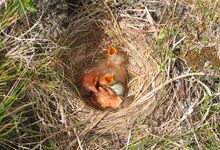
Cup nest of a Redwing (Turdus iliacus), with newly hatched chicks
The cup nest is smoothly hemispherical inside, with a deep depression to house the eggs. Most are made of pliable materials—including grasses—though a small number of made of mud. Many passerines build this type of nest.
Saucer or plate[]
The saucer or plate nest, though superficially similar to a cup nest, has at most only a shallow depression to house the eggs.
Platform[]
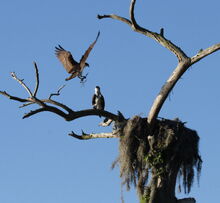
The huge platform nest of the Osprey (Pandion haliaetus)
The platform nest is a large structure, often many times the size of the birds which build and use it. In the case of raptor nests, or eyries, these are often used for many years, with new material added each breeding season. In some cases, the nests grow large enough to cause structural damage to the tree itself, particularly during bad storms where the weight of the nest can cause additional stress on wind-tossed branches.
Pendant[]
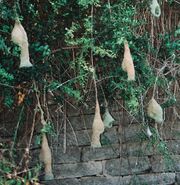
Pendant nests of Baya Weavers
The pendant nest is an elongated sac, which is suspended from a branch. Some examples include those made by weaver birds and sunbirds.
Sphere[]
The sphere nest is a roundish structure; it is completely enclosed, except for a small opening which allows access.
Nest protection and sanitation[]
Many species of bird conceal their nests to protect them from predators. Some species may choose nest sites that are inaccessible. Some may make specific modifications to keep predators at bay. Bird nests can also act as habitats for other inquiline species which may not affect the bird directly. Birds have also evolved nest sanitation measures to reduce the effects of parasites and pathogens on nestlings.
Some aquatic species such as Grebes are very careful when approaching and leaving the nest so as not to reveal the location. Some species will use leaves to cover up the nest prior to leaving.
Ground birds such as plovers may use broken wing or rodent run displays to distract predators from nests.[39]
Cavity-dwelling species have to contend with the danger of predators accessing their nest, catching them and their young inside and unable to get out. They have a variety of methods for decreasing the likelihood of this happening. Red-cockaded Woodpeckers peel bark around the entrance, and drill wells above and below the hole; since they nest in live trees, the resulting flow of resin forms a barrier that prevents snakes from reaching the nests.[40] Red-breasted Nuthatches smear sap around the entrance holes to their nests, while White-breasted Nuthatches rub foul-smelling insects around theirs.[41] Eurasian Nuthatches wall up part of their entrance holes with mud, decreasing the size and sometimes extending the tunnel part of the chamber. Most female hornbills seal themselves into their cavity nests, using a combination of mud (in some species brought by their mates), food remains and their own droppings to reduce the entrance hole to a narrow slit.[42]
Nests can become home to many other organisms including parasites and pathogens. The excreta of the fledglings also pose a problem. In most passerines, the adults actively dispose the fecal sacs of young at a distance or consume them. This is believed to help prevent ground predators from detecting nests.[43] Young birds of prey however usually void their excreta beyond the rims of their nests.[44] Blowflies of the genus Protocalliphora have specialized to become obligate nest parasites with the maggots feeding on the blood of nestlings.[45]
Some birds have been shown to choose aromatic green plant material for constructing nests that may have insecticidal properties, [46][47] while others may use materials such as carnivore scat to repel smaller predators.[48]
Colonial nesting[]
- Main article: Bird colony
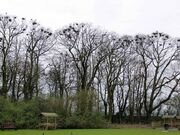
Nesting colony of Rooks and Eurasian Jackdaws
Though most birds nest individually, some species—including penguins, flamingoes, many herons, gulls, terns, seabirds, weavers, some corvids and some sparrows—gather together in sizeable colonies. Birds that nest colonially may benefit from increased protection against predation. They may also be able to better utilize food supplies, by following more successful foragers to their foraging sites.
In human culture[]
Many birds nest close to human habitations and some have been specially encouraged. Nesting White Storks have been protected and held in reverence in many cultures.[49] Nest boxes are often used to encourage cavity nesting birds. The nesting of Peregrine Falcons on tall buildings has captured popular interest.[50] Colonial breeders produce guano which is a valuable fertilizer. The saliva nests of Cave Swiftlets are used to make Bird's nest soup in parts of Southeast Asia.
Some species of birds are also considered nuisances when they nest in the proximity of human habitations. Feral pigeons are often unwelcome and sometimes also considered as a health risk.[51]
Citations[]
- ↑ 1.0 1.1 1.2 1.3 Campbell & Lack 1985, p. 386
- ↑ Campbell & Lack 1985, p. 345
- ↑ Campbell & Lack 1985, p. 387
- ↑ Ehrlich et al. 1994, pp. 228-232
- ↑ del Hoyo, Elliott & Sargatal 1992, p. 692
- ↑ del Hoyo, Elliott & Sargatal 1992, p. 148
- ↑ Ehrlich et al. 1994, p. 252
- ↑ Ehrlich et al. 1994, p. 260
- ↑ Jaramillo 2001, p. 548
- ↑ Campbell & Lack 1985, p. 390
- ↑ Ehrlich et al. 1994, p. xxii
- ↑ Ehrlich et al. 1994, p. 441
- ↑ Campbell & Lack 1985, p. 174
- ↑ Campbell & Lack 1985, p. 145
- ↑ del Hoyo, Elliott & Sargatal 1996, p. 637
- ↑ del Hoyo, Elliott & Sargatal 1996, p. 673
- ↑ del Hoyo, Elliott & Sargatal 1992, p. 80
- ↑ del Hoyo, Elliott & Sargatal 1992, p. 119
- ↑ del Hoyo, Elliott & Sargatal 1996, p. 222
- ↑ del Hoyo, Elliott & Sargatal 1996, p. 473
- ↑ del Hoyo, Elliott & Sargatal 1992, p. 558
- ↑ del Hoyo, Elliott & Sargatal 1996, p. 371
- ↑ 23.0 23.1 23.2 23.3 Elliott 1994, p. 287
- ↑ Hansell 2000, p. 9
- ↑ 25.0 25.1 Elliott 1994, p. 288
- ↑ Elliott 1994, p. 280
- ↑ Göth 2007, pp. 378-385
- ↑ Harrap & Quinn 1996, p. 21
- ↑ Woodall 2001, p. 169
- ↑ Ehrlich et al. 1994, p. xxiii
- ↑ Ehrlich et al. 1994, p. 345
- ↑ Juniper & Parr 2003, p. 24
- ↑ 33.0 33.1 Collar 2001, p. 94
- ↑ 34.0 34.1 34.2 Reed 2001, p. 380–1
- ↑ Brightsmith 2000, p. 529
- ↑ 36.0 36.1 Collar 2001, p. 96
- ↑ 37.0 37.1 Conner 1975, p. 373
- ↑ 38.0 38.1 Rendell & Robertson 1994, pp. 27-35
- ↑ Byrktedal 1989
- ↑ Rudolph, Kyle & Conner 1990
- ↑ Reed 2001, p. 437
- ↑ Kemp 2001, p. 469
- ↑ Petit, Petit & Petit 1989
- ↑ Rosenfeld, Rosenfeld & Gratson 1982
- ↑ Sabrosky, Bennett & Whitworth 1989
- ↑ Wimberger 1984
- ↑ Clark & Mason 1985
- ↑ Schuetz 2005
- ↑ Kushlan 1997
- ↑ Cade & Bird 1990
- ↑ Haag-Wackernagel & Moch 2004
References[]
- Brightsmith, Donald J. (2000), "Use of Arboreal Termitaria by Nesting Peruvian Amazon", The Condor 102: 529-538
- Byrktedal, Ingvar (1989), "Nest defense behavior of Lesser Golden-Plovers.", Wilson Bull. 101 (4): 579-590, http://elibrary.unm.edu/sora/Wilson/v101n04/p0579-p0590.pdf
- Cade, T.J.; Bird, D.M. (1990), "Peregrine Falcons (Falco peregrinus) nesting in an urban environment: a review.", Can. Field-Naturalist 104: 209-218
- Campbell, Bruce; Lack, Elizabeth, eds. (1985), A Dictionary of Birds, Carlton, England: T and A D Poyser, ISBN 0-85661-039-9
- Clark, L.; Mason, J. Russell (1985), "Use of nest material as insecticidal and anti-pathogenic agents by the European Starling.", Oecologia 67 (2): 169-176, http://www.springerlink.com/content/w4v7u418463h3v90/
- Collar, N. J. (2001), "Family Trogonidae (Trogons)", in del Hoyo, Josep; Elliott, Andrew; Sargatal, Jordi, Handbook of Birds of the World, Volume 6: Mousebirds to Hornbills, Barcelona: Lynx Edicions, ISBN 84-87334-30-X
- Conner, Richard N. (1975), "Orientation of entrances to woodpecker nest cavities", Auk 92: 371-374
- del Hoyo, Josep; Elliott, Andrew; Sargatal, Jordi, eds. (1996), Handbook of Birds of the World, vol. 3, Barcelona: Lynx Edicions, ISBN 84-87334-20-2
- Ehrlich, Paul R.; Dobkin, David S.; Wheye, Darryl; Pimm, Stuart L. (1994), The Birdwatcher's Handbook, Oxford: Oxford University Press, ISBN 0198584075
- Elliott, Andrew (1994), "Family Megapodiidae (Megapodes)", in del Hoyo, Josep; Elliott, Andrew; Sargatal, Jordi, Handbook of Birds of the World, Volume 2: New World Vultures to Guineafowl, Barcelona: Lynx Edicions, ISBN 84-87334-15-6
- Göth, Anne (2007), "Incubation temperatures and sex ratios in Australian brush-turkey (Alectura lathami) mounds", Austral Ecology 32 (4): 278-285
- Haag-Wackernagel, D; Moch, H. (48), "Health hazards posed by feral pigeons.", J. Infect.: 307-313
- Hansell, Mike (2000), Bird Nests and Construction Behaviour, Cambridge University Press, ISBN 0521017645
- Harrap, Simon; Quinn, David (1996), Tits, Nuthatches & Treecreepers, London: Christopher Helm, ISBN 0-7136-3964-4
- Jaramillo, Alvaro (2001), "Blackbirds, Orioles and Allies", in Elphick, Chris; Dunning, Jr., John B.; Sibley, David, The Sibley Guide to Bird Life & Behaviour, London: Christopher Helm, ISBN 0-7136-6250-6
- Juniper, Tony; Parr, Mike (2003), Parrots: A Guide to the Parrots of the World, London: Christopher Helm, ISBN 0-7136-6933-0
- Kemp, A. C. (2001), "Family Bucerotidae (Hornbills)", in del Hoyo, Josep; Elliott, Andrew; Sargatal, Jordi, Handbook of Birds of the World, Volume 6: Mousebirds to Hornbills, Barcelona: Lynx Edicions, ISBN 84-87334-30-X
- Kushlan, James A. (1997), "The Conservation of Wading Birds.", Colonial Waterbirds 20 (1): 129-137, doi:
- Petit, Kenneth E.; Petit, Lisa J.; Petit, Daniel R. (1989), "Fecal Sac Removal: Do the Pattern and Distance of Dispersal Affect the Chance of Nest Predation?", The Condor 91 (2): 479-482, http://elibrary.unm.edu/sora/Condor/files/issues/v091n02/p0479-p0482.pdf
- Reed, J. Michael (2001), "Woodpeckers and Allies", in Elphick, Chris; Dunning, Jr., John B.; Sibley, David, The Sibley Guide to Bird Life & Behaviour, London: Christopher Helm, ISBN 0-7136-6250-6
- Rendell, Wallace B.; Robertson, Raleigh J. (1994), "Cavity Entry Orientation and Nest-site Use by Secondary Hole-nesting Birds", Journal of Field Ornithology 65 (1): 27-35
- Rosenfeld, R.N.; Rosenfeld, A. J.; Gratson, M. W. (1982), "Unusual Nest Sanitation by a Broad-Winged Hawk.", The Wilson Bulletin 94 (3): 2365-366, http://elibrary.unm.edu/sora/Wilson/v094n03/p0365-p0366.pdf
- Rudolph, D. C.; Kyle, H.; Conner, R. N. (1990), "Red-cockaded woodpeckers vs. Rat Snakes: The effectiveness of the resin barrier.", Wilson Bull. 102(l): 14-22, http://elibrary.unm.edu/sora/Wilson/v102n01/p0014-p0022.pdf
- Sabrosky, Curtis W.; Bennett, G. F.; Whitworth, T. L. (1989), Bird blow-flies (Protocalliphora) (Diptera: Calliphoridae) in North America with notes on the Palearctic species., Smithsonian Institution Press, Washington.
- Schuetz, Justin G. (2005), "Common waxbills use carnivore scat to reduce the risk of nest predation.", Behavioral Ecology 16 (1): 133-137, http://beheco.oxfordjournals.org/cgi/content/full/16/1/133
- Wimberger, P. H. (1984), "The use of green plant material in bird nests to avoid ectoparasites.", Auk 101: 615-616, http://elibrary.unm.edu/sora/Auk/v101n03/p0615-p0618.pdf
External links[]
- Lecture notes on bird nesting
- Natural history museum of Los Angeles - Bird nesting
- Department of natural resources Illinois state
- Earthlife site on bird nests
- Bird nests - teaching activity resource
Birds | |
|---|---|
| Anatomy | |
| Evolution |
Archaeopteryx · Enantiornithes · Hesperornithes · Hybridisation · Late Quaternary prehistoric birds · Fossils · Taxonomy · Extinction |
| Behaviour |
Singing · Intelligence · Migration · Reproduction · Incubation · Brood parasites · Nesting |
| Bird Orders |
Struthioniformes · Tinamiformes · Anseriformes · Galliformes · Gaviiformes · Podicipediformes · Procellariiformes · Sphenisciformes · Pelecaniformes · Ciconiiformes · Phoenicopteriformes · Falconiformes · Gruiformes · Charadriiformes · Pteroclidiformes · Columbiformes · Psittaciformes · Cuculiformes · Strigiformes · Caprimulgiformes · Apodiformes · Coraciiformes · Piciformes · Trogoniformes · Coliiformes · Passeriformes |
| Bird lists |
Familes and orders · Lists by region |
| Birds and humans |
Ringing · Ornithology · Bird collections · Birdwatching · Bird feeding · Conservation · Aviculture |
| Category · Portal | |
| This page uses Creative Commons Licensed content from Wikipedia (view authors). |